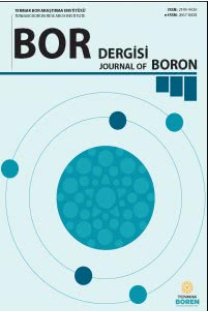Optimization of Removal of Calcium Ions Forming During Synthesis of Boric Acid from Ulexite Ore by Using Ion Exchange Resin
Ulexite (Na2O·2CaO·5B2O3·16H2O) is one of the most important raw materials for boric acid, synthesized by dissolving the ore in an acid solution. Since ulexite ore was dissolved in a phosphoric acid solution, the final solution included boric acid (H3BO3), sodium dihydrogen phosphate [NaH2PO4], and calcium dihydrogen phosphate [Ca(H2PO4)2]. The presence of several ions in the solution causes separation problems for boric acid. This study includes a special separation step to increase the purity of the boric acid that is synthesized from the dissolution of ulexite ore in phosphoric acid. For this purpose, calcium ions in the final solution were removed using Dowex HCR-S cationic ion exchange resin. Additionally, the Taguchi optimization method was employed to monitor the removal of calcium ions. The design of experiments included an orthogonal array technique in L9 array for three parameters with three different values; reaction temperature (12 oC, 25 oC, 40 oC), stirring rate (250 rpm, 300 rpm, 350 rpm), and the amount of resin material (10% wt., 30% wt., 50% wt.). The results of the calculations revealed that the optimum values of temperature, stirring rate, and amount of resin are 12 oC, 350 rpm, and 50% wt., respectively. The amount of calcium removed under optimum conditions was found as 79.49%.
Keywords:
Ulexite, Boric Acid Calcium Removal, Ion Exchange Resin,
___
- [1] İçelli O, Erzeneoğlu S, Boncukcuoğlu R. “Measurement of X-ray transmission factors of some boron compounds”. Radiation Measurements, 37, 613-616, 2003. [2] Künkül A, Yapici S, Kocakerim MM, Copur M. “Dissolution kinetics of ulexite in ammonia solutions saturated with CO2”. Hydrometallurgy, 44, 135-145, 1997. [3] Imamutdinova VM. “Rates of dissolution of native borates in H3PO4 solutions”. Journal of applied chemistry of the USSR, 40, 2596-2598, 1967. [4] Temur H, Yartaşı A, Çopur M, Kocakerim MM. “The kinetics of dissolution of colemanite in H3PO4 solutions”. Industrial and Engineering Chemistry Research, 39, 4114-4119, 2000. [5] Küçük Ö, Kocakerim MM, Yartaşı A, Çopur M. “Dissolution of kestelek’s colemanite containing clay minerals in water saturated with sulphur dioxide”. Ind. Eng. Chem. Res., 41, 2853-2857, 2002. [6] Doğan HT, Yartaşı A. “Kinetic investigation of reaction between ulexite ore and phosphoric acid”. Hydrometallurgy, 96, 294-299, 2009. [7] Kizilca M, Copur M. “Kinetic investigation of reaction between colemanite ore and methanol”. Chemical Engineering Communications, 202, 1528-1534, 2015. [8] Küçük Ö. “Application of Taguchi method in the optimization of dissolution of ulexite in NH4Cl solutions”. Korean J. Chem. Eng., 23, 21-27, 2006. [9] Ekinci Z, Şayan E, Beşe AV, Ata ON. “Optimization and modeling of boric acid extraction from colemanite in water saturated with carbon dioxide and sulphur dioxide gases”. Int. J. Miner. Process., 82, 187-194, 2007. [10] Doğan TH, Yartaşı A. “Optimization of dissolution of ulexite in phosphate acid solutions”. J.Chem.Soc.Pak., 36, 601-605, 2014. [11] Taguchi G. “Introduction to quality engineering”. New York: Mc Graw-Hill, 1990. [12] Çopur M. “An optimization study of dissolution of Zn and Cu in ZnS concentrate with HNO3 solutions”. Chem. Biochem. Eng., 15, 191-197, 2002. [13] Phadke MS. “Quality engineering using robust design”. Prentice Hall: New Jersey, 61-292, 1989. [14] Roy RK. “A Primer on the Taguchi Method; Competitive Manufacturing Series”. 1990. [15] Wu Y, Wu A. “Taguchi methods for robust design”. The Park Avenue, New York: The American Society of Mechanical Engineers, 2000. [16] Scott WW. “Standard Methods of Chemical Analysis”. Van Nostrand: New York, 1963.
- ISSN: 2149-9020
- Yayın Aralığı: Yılda 4 Sayı
- Başlangıç: 2016
- Yayıncı: TENMAK Bor Araştırma Enstitüsü
Sayıdaki Diğer Makaleler
Dry sliding behaviour of boron waste reinforced epoxy matrix composites
Nurcan ÇALIŞ AÇIKBAŞ, Bilge YAMAN
Tuba Hatice DOĞAN, Ahmet YARTAŞI
Tuba ÖZDEMİR, Ali Ünsal KESKİNER
Bilge Yaman, Nurcan Çalış Açıkbaş
ÜLEKSİT VE BORAKS İÇEREN FREN SÜRTÜNME MALZEMELERİNİN TRİBOLOJİK ÖZELLİKLERİ
Banu SUGÖZÜ, B. Barış BULDUM, İlker SUGÖZÜ
Selim UYSAL, Jed CAPPELLAZZİ, Jeffrey MORRELL
The nanobiocomposites synthesis from biomass and its characterization
